

The Italian Republic, a 700-mile-long peninsula extending into the heart of the Mediterranean Sea, has an area of 116,304 sq. mi. (301,230 sq. km.) and a population of 60 million. Capital: Rome. The economy centers around agriculture, manufacturing, forestry and fishing. Machinery, textiles, clothing and motor vehicles are exported.
From the fall of Rome until modern times, ‘Italy’ was little more than a geographical expression. Although nominally included in the Empire of Charlemagne and the Holy Roman Empire, it was in reality divided into a number of independent states and kingdoms presided over by wealthy families, soldiers of fortune or hereditary rulers. The 19th century unification movement fostered by Mazzini, Garibaldi and Cavour attained fruition in 1860-70 with the creation of the Kingdom of Italy and the installation of Victor Emmanuel, king of Sardinia, as king of Italy. Benito Mussolini came to power during the post-World War I period of economic and political unrest, and installed a Fascist dictatorship with a figurehead king as titular Head of State. Mussolini entered Italy into the German-Japanese anti-comitern pact (Tri-Partite Pact) and withdrew from the League of Nations. The war did not go well for Italy and Germany was forced to assist Italy in its failed invasion of Greece. The Allied invasion of Sicily on July 10, 1943 and bombings of Rome brought the Fascist council to a no vote of confidence on July 23, 1943. Mussolini was arrested but soon escaped and set up a government in Salo. Rome fell to the Allied forces in June, 1944 and the country was allowed the status of cobelligerent against Germany. The Germans held northern Italy for another year. Mussolini was eventually captured and executed by partisans.
Following the defeat of the Axis powers, the Italian monarchy was dissolved by plebiscite, and the Italian Republic proclaimed.
Modello 1874
This was the first handgun adopted by the Kingdom of Italy’s military forces. It was very similar to the French Model 1874 and is chambered for the 10.35mm cartridge. It is fitted with a 6.3” octagon barrel. Cylinder is fluted and grips are checkered wood with lanyard loop. Built by Siderugica Glisenti and others. Weight is about 40 oz. In use by the Italian military from 1872 to 1943.
Exc. |
V.G. |
Good |
Fair |
900 |
600 |
350 |
200 |
System Bodeo Modello 1889 (Enlisted Model)
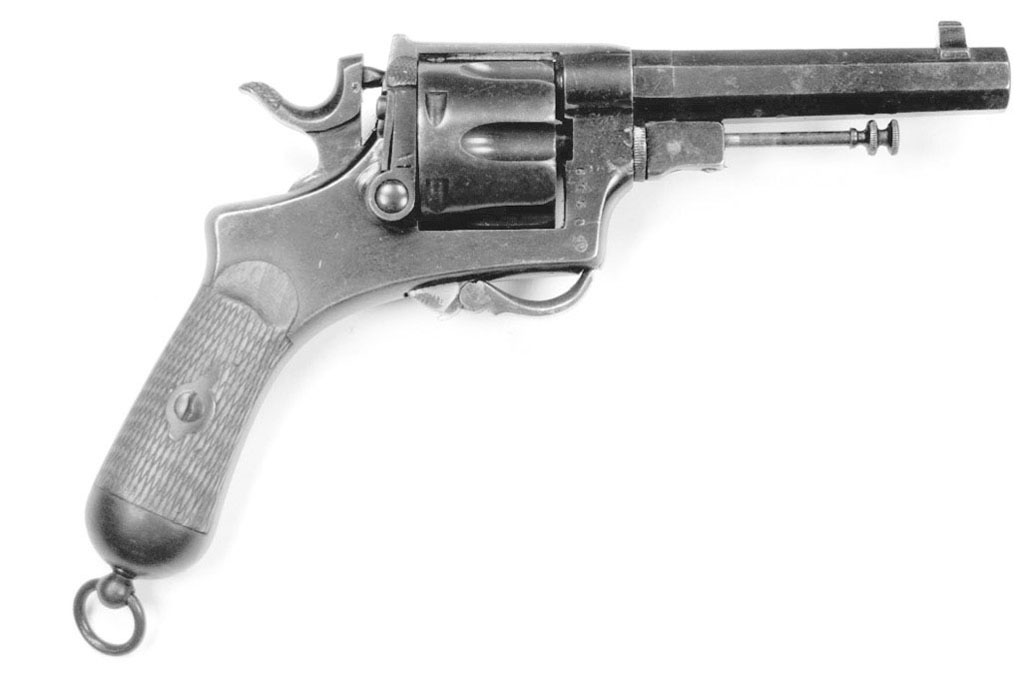
Courtesy Rock Island Auction Company
A 10.4mm caliber revolver with a 4.5” octagonal barrel and 6-shot cylinder. Folding trigger, no trigger guard. Built on a Chamelot-Delvigne frame with loading gate on the right side. This revolver was adopted as the Italian service revolver in 1889 and was replaced by the Glisenti in 1910. Manufactured by various Italian arms companies. This revolver, in different configurations, remained in service until 1945.
Exc. |
V.G. |
Good |
Fair |
500 |
350 |
250 |
150 |


Modello 1874 • Courtesy Supica’’s Old Town Station
Modello 1889 (Officer’s Model)
Essentially the same as the enlisted man’s model with a round barrel, non-folding trigger, and conventional triggerguard.
Exc. |
V.G. |
Good |
Fair |
500 |
350 |
250 |
150 |
Glisenti Model 1910
A 9mm Glisenti caliber semi-automatic pistol with a 3.9” barrel, fixed sights, and 7-shot magazine. Weight is about 30 oz. Manufactured from 1910 to 1915. As many as 100,000 of these pistols were produced and used during World War II.

Modello 1889 (Officer’s Model) • Courtesy Richard M. Kumor Sr.

Courtesy Faintich Auction Service • Photo Paul Goodwin

Model 1910 with black plastic grips with crown • Courtesy Richard M. Kumor Sr.
WARNING: Standard 9×19 ammo must not be fired in this gun.
Exc. |
V.G. |
Good |
Fair |
750 |
550 |
400 |
250 |
Model 1915
A 7.65mm caliber semi-automatic pistol with 3.5” barrel, fixed sights, and 7-shot magazine. Blued with walnut grips. Weight is about 20 oz. The slide is marked “PIETRO BERETTA BRESCIA CASA FONDATA NEL 1680 CAL. 7.65MM BREVETTO 1915.” Manufactured between 1915 and 1922. Used by the Italian military during WWI and WWII. About 65,000 were produced, most of which were not martially marked.

9mm Glisenti M1910 magazine. Price 150-70

Courtesy Rock Island Auction Company
Exc. |
V.G. |
Good |
Fair |
800 |
600 |
400 |
200 |
Model 1915 2nd Variation
As above, in 9mm Glisenti caliber with 3.75” barrel. Checkered wood grips. Weight is about 32 oz.
Exc. |
V.G. |
Good |
Fair |
1000 |
750 |
500 |
250 |
Model 1915/1919
This model is an improved version of the above pistol but chambered for the 7.65mm cartridge. It also incorporates a new barrel-mounting method and a longer cutout in the top of the slide. Produced from 1922 to 1931 for the Italian military with about 50,000 manufactured, most without military markings.

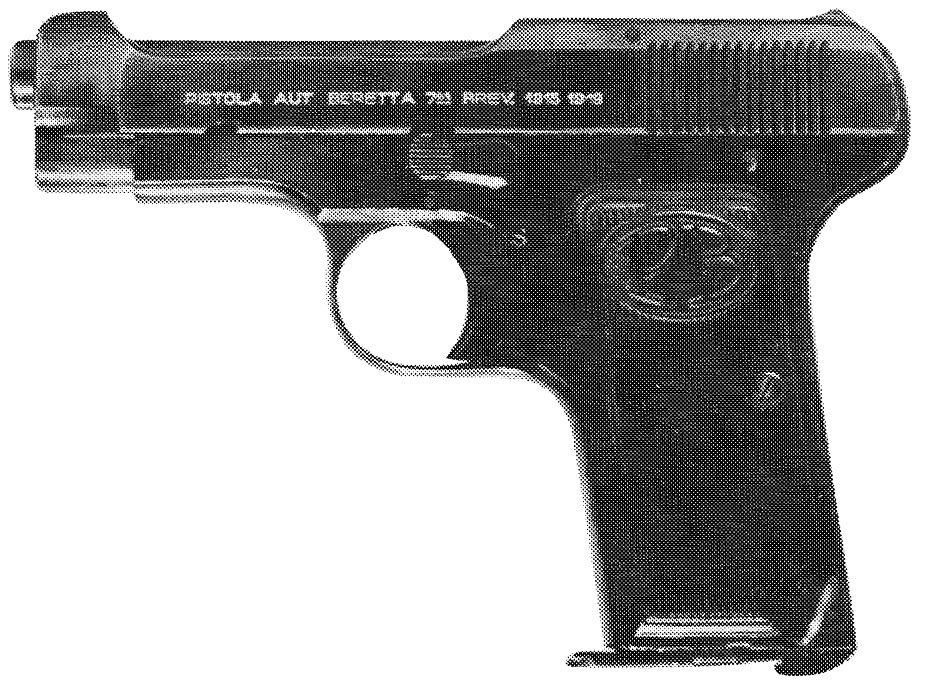
Courtesy Orvel Reichert
Exc. |
V.G. |
Good |
Fair |
600 |
450 |
300 |
150 |
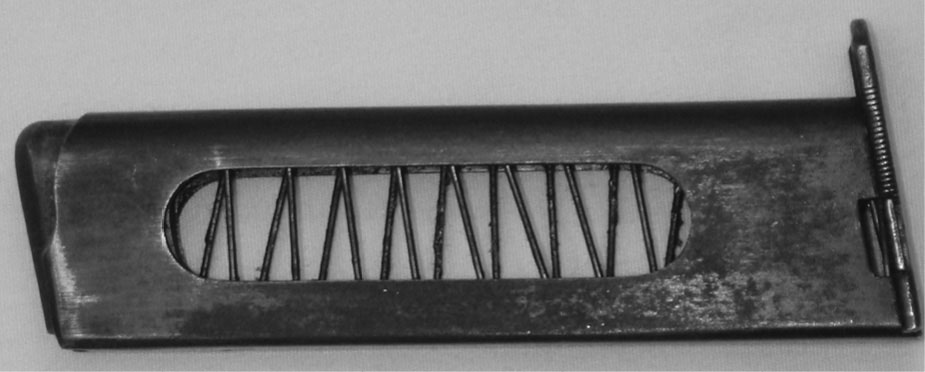
Beretta Model 1915-1919 magazine 7.65mm. Price 65-40
Model 1923
A 9mm caliber semi-automatic pistol with 4” barrel and 8-shot magazine. Blued with steel grips. The slide is marked “Brev 1915-1919 Mlo 1923.” Exposed hammer. Italian army markings on left grip tang. Some pistols are cut for a shoulder stock. Manufactured from 1923 to 1935. Approximately 10,000 manufactured.
Exc. |
V.G. |
Good |
Fair |
1500 |
1100 |
700 |
400 |

Model 1931

A 7.65mm caliber semi-automatic pistol with 3.5” barrel and open-top slide. Blued with walnut grips and marked “RM” separated by an anchor. Issue limited to the Italian navy. Produced from 1931 to 1934 for the Italian navy. Approximately 8,000 manufactured.
Exc. |
V.G. |
Good |
Fair |
800 |
650 |
400 |
200 |
Model 1934
As above, with 9mm Corto (Kurz) caliber. The slide is marked, “P. Beretta Cal. 9 Corto-Mo 1934 Brevet Gardone VT.” This inscription is followed by the date of manufacture that was given numerically, followed by a Roman numeral that denoted the year of manufacture on the Fascist calendar, which began in 1922. This model was the most common prewar Beretta pistol and was widely used by all branches of the Italian military. Examples are marked “RM” (navy), “RE” (army), “RA” (air force), and “PS” (police). Manufactured between 1934 and 1959.

Courtesy Orvel Reichert

Courtesy Orvel Reichert
Exc. |
V.G. |
Good |
Fair |
550 |
450 |
350 |
200 |
Air Force “RA” marked
Exc. |
V.G. |
Good |
Fair |
675 |
550 |
400 |
225 |
Navy “RM” marked
Exc. |
V.G. |
Good |
Fair |
750 |
650 |
475 |
250 |
Holster for Beretta Model 1934 and 1935
Leather construction. Top flap. Single magazine pouch on the front. Single belt loop on back. Some WWII era versions were dyed a green color. Price range 150 - 50

Model 1934 Romanian Contract
See Romania, Handguns.
Model 1935
As above, in 7.65mm caliber. Manufactured from 1935 to 1959. A number of these pistols were built and used by the German army during the occupation of Italy in World War II. Some of these pistols are marked with 4UT in an oval. Pistols produced in 1944 and 1945 were likely used by the German army without markings. Some of these wartime pistols are marked with Italian navy or air force markings. Production between 1934 and 1943 was about 200,000 pistols. Production continued after WWII. Deduct 20 percent for post-war dated commercial pistols.

Model 1935 • Courtesy Orvel Reichert
Exc. |
V.G. |
Good |
Fair |
550 |
400 |
300 |
150 |
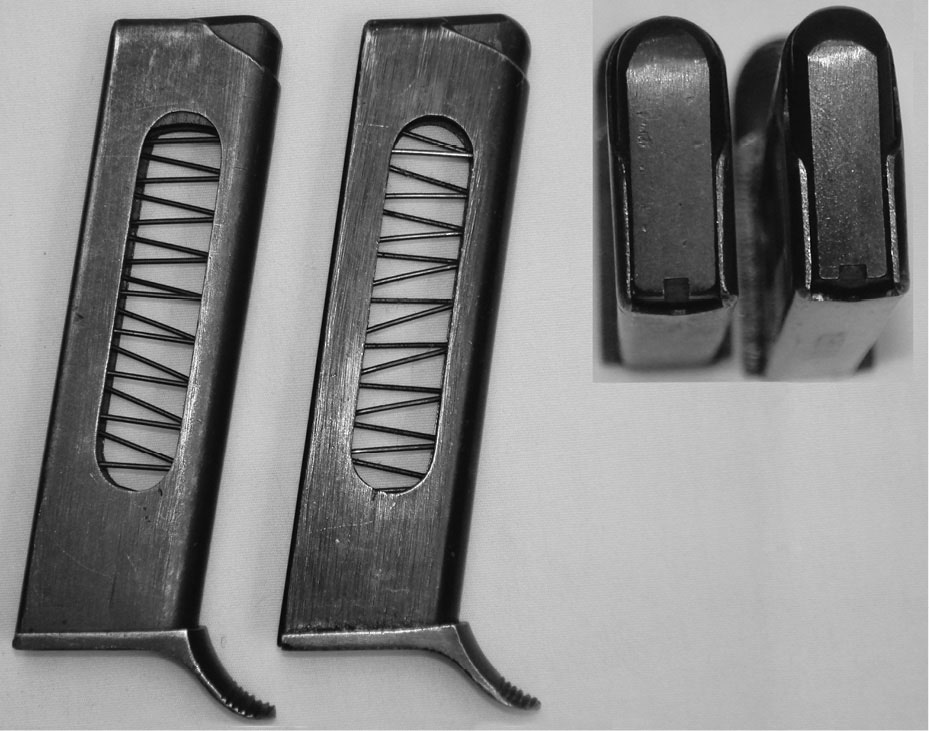
Beretta Models 1934 (l) and 1935 magazines (r). Difference is visible from the top. price 65-30
Model 1951
Chambered for the 7.65 or 9mm cartridges, this model was fitted with a 4.5” barrel and had an 8-round magazine. Fixed sights. Weight was about 31 oz. This pistol was used by the Italian military as well as by Egypt and Israel. Sold commercially under the name “Brigadier.”
Exc. |
V.G. |
Good |
Fair |
600 |
475 |
350 |
250 |
NOTE: See Egypt, Helwan

Model 92
A 9mm caliber double-action, semi-automatic pistol with a 5” barrel, fixed sights, and a 16-round, double-stack magazine. Blued with plastic grips. Introduced in 1976 and is now discontinued. This model was used by the Italian State Police forces. The U.S. military version, the M9, is based on this series. Price given is for commercial pistols. It is not known if any Italian military issue Beretta 92’s have been imported.
NOTE: There are a number of different versions of this pistol. The main differences lie in the safety type and magazine release, barrel length, and magazine capacity.

NIB |
Exc. |
V.G. |
Good |
500 |
450 |
400 |
250 |
Italy also uses the HK MP5A3 and MP5SD in its police
and anti-terrorist units.
Villar Perosa Model 1915
This was the first submachine gun adopted by any military force. Chambered for the 9×19mm Glisenti cartridge. Barrel length is 12.5”. Its rate of fire was about 1200 rounds per minute. Fed by a 25-round box top-mounted magazine. This gun was designed to be mounted in pairs on aircraft, various types of vehicles, and from fixed mounts with its spade grip. Weight of pair is about 14 lbs.
Pre-1968 (Very Rare)
Exc. |
V.G. |
Fair |
25000 |
22500 |
20000 |
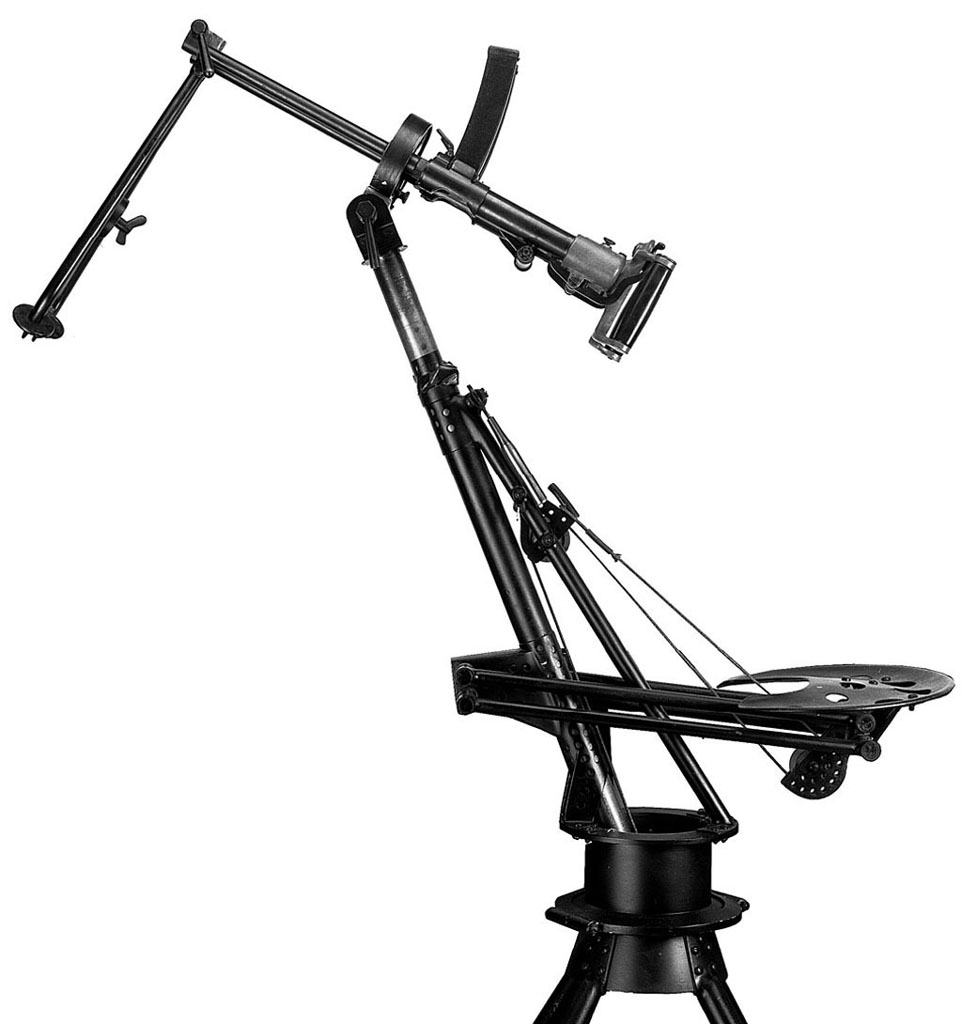

Twin Villar Perosa guns in simulated aircraft mount • Courtesy private NFA collection, Paul Goodwin photo
Villar Perosa Model 1918 (Beretta)
This gun is an adapted Villar Perosa fitted into a wooden stock with new trigger mechanism. Most of the original M1915 Villar Perosa’s were converted to the Model 1918. Barrel length is 12.5”. Magazine capacity is 25 rounds. Rate of fire is about 900 rounds per minute. Select fire. Weight is about 8 lbs. This gun was used by the Italian army from the end of WWI to WWII.

Beretta Model 1918 • Courtesy Thomas Nelson, The World’s Submachine Guns, Vol. 1
Pre-1968 (Extremely Rare)
Exc. |
V.G. |
Fair |
9500 |
9000 |
8000 |
Beretta Model 1938A
This Italian-made submachine gun is chambered for the 9mm Parabellum cartridge and was produced from 1938 to about 1950. It was in use by German, Italian, and Romanian armies in different eras. Argentina also purchased a number of Model 38As directly from Beretta. It is fitted with a 12.25” barrel, full rifle-style stock, and has a magazine capacity of 10, 20, 30, or 40 rounds. Its rate of fire is 600 rounds per minute. Markings on top of receiver are “MOSCHETTI AUT-BERETTA MOD 1938A BEREVETTO NO 828 428 GARDONE V.T. ITALIA.” This weapon was fitted with two triggers: The front trigger fires in the semi-automatic mode, and the rear trigger fires in the automatic mode. A few early models were fitted with a bayonet lug. Weight is about 9.25 lbs.
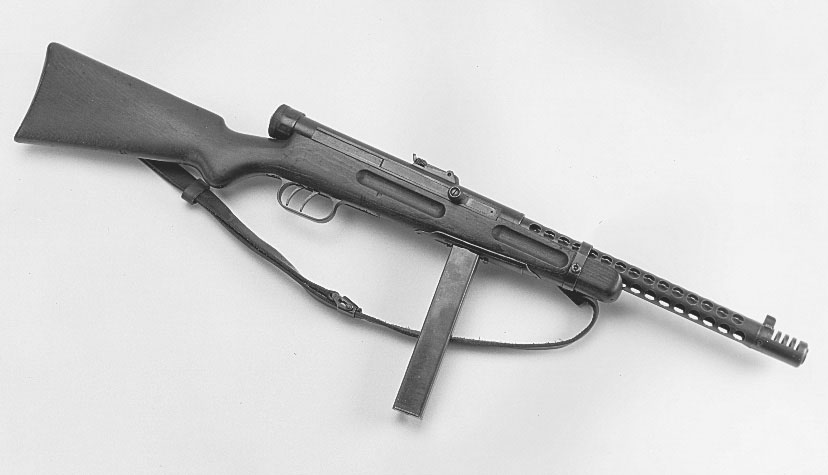
Private NFA collection • Photo by Gary Gelson
Pre-1968
Exc. |
V.G. |
Fair |
12500 |
10000 |
7500 |
Beretta Model 38/42
This is an improved wartime version of the Model 1938 without the barrel shroud. This was a less-well-finished model than the Model 1938A. Barrel length is a little over 8”. Rate of fire is about 550 rounds per minute. Magazine capacity is 20 or 40 rounds. Produced from 1943 to about 1975. Weight is approximately 7 lbs. Marked “M.P. BERETTA MOD 38/42 CAL 9” on the top of the receiver. This model was used by Italian and German troops in Italy in the latter stages of World War II. Some of these guns were sold to Romania in 1944.
NOTE: A simplified version of the Model 38/42 is designated the Model 38/44 and features a lighter and more simple bolt design and main operating spring. This main spring is very similar to the one used in the British Sten gun. The Model 38/ 44 was sold to Syria, Pakistan, Iraq, and Costa Rica, among others, following WWII.

Beretta Model 38/42 • Private NFA collection, Paul Goodwin photo
Pre-1968
Exc. |
V.G. |
Fair |
10500 |
8500 |
7000 |
F.N.A.-B Model 1943
This Italian submachine gun was built in 1943 and 1944. It is fitted with a 7.75” shrouded barrel. Chambered for the 9mm cartridge. Magazine capacity is 20 or 40 rounds with a machined magazine housing that folds forward when not in use. Rate of fire is 400 rounds per minute. The gun fires from the closed bolt position. It is made entirely of machined steel. It is estimated that some 7,000 of these guns were produced and were used by both Italian and German troops in WWII.


Pre-1968 (Rare)
Exc. |
V.G. |
Fair |
12500 |
11000 |
10000 |
Beretta Model 12
Chambered for the 9mm Parabellum cartridge, this sub gun was produced from 1959 to about 1978. It was manufactured basically from steel stampings.
Fitted with a bolt that wraps around the barrel. Also fitted with a front vertical hand grip and either a folding metal stock or detachable wood stock. First used by Italian military in 1961. Also used in South America and Africa. Barrel is 7.75” long with a magazine capacity of 20, 30, or 40 rounds. Rate of fire is 500 rounds per minute. Marked “MOD12-CAL9/M PARABELLUM” on the top of the receiver. Weight is about 6.5 lbs.
Pre-1968 (Rare)
Exc. |
V.G. |
Fair |
12500 |
11000 |
10000 |
Beretta Model 12S
Similar to the Model 12 but with an improved safety system, sights, and folding stock fixture. Production began in 1978 when it replaced the Model 12.

Courtesy private NFA collection
Pre-1968
Exc. |
V.G. |
Fair |
N/A |
N/A |
N/A |
Franchi LF-57
First produced in Italy in 1960, this submachine gun is chambered for the 9mm cartridge. It was placed in service with the Italian navy. Produced until 1980. It is fitted with an 8” barrel and has a magazine capacity of 20 or 40 rounds. Equipped with a folding stock. Rate of fire is about 500 rounds per minute. Marked “S P A LUIGI FRANCHI-BRESCIA-CAL9P.” Weight is 7 lbs.
Pre-1968
Exc. |
V.G. |
Fair |
9500 |
8500 |
7500 |
Beretta Model 93R
Built of the Beretta Model 92 frame and slide, this machine pistol is chambered for the 9mm Parabellum cartridge. It is fitted with a 6.1” barrel with muzzle brake and uses a 15- or 20-round magazine. Can be fitted with a shoulder stock. Rate of fire is about 1,100 rounds per minute. Has a 3-round burst mode, and a small swing-down metal foregrip mounted on the front of the triggerguard. Weight is about 2.5 lbs. Used by the Italian anti-terrorist units.
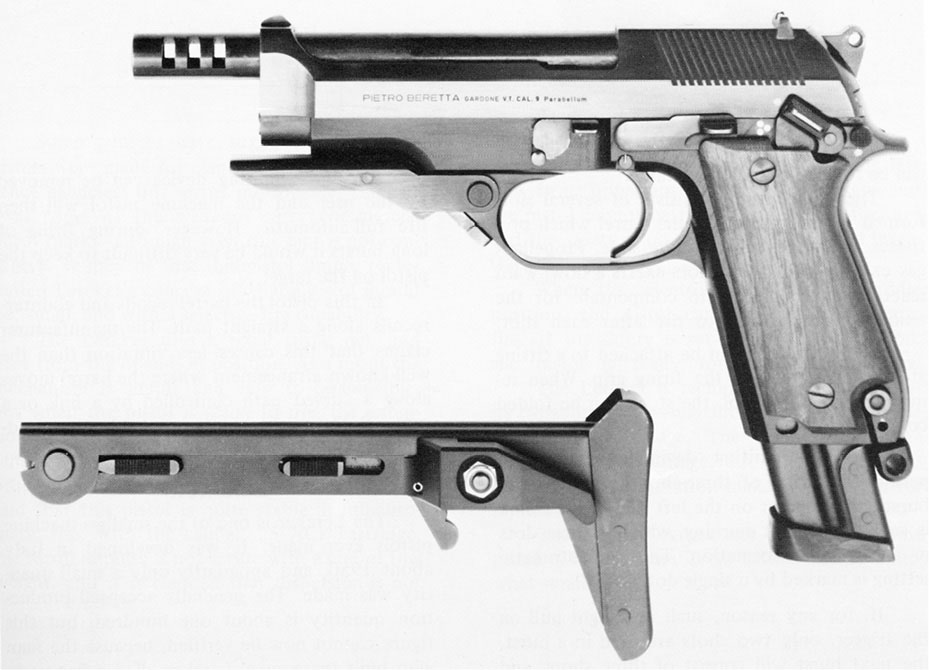
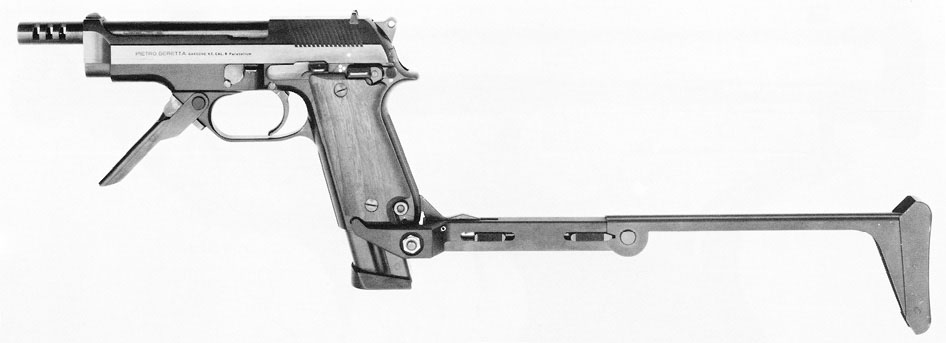
Beretta Model 93R • Courtesy Thomas Nelson, The World’s Machine Pistols, Vol. II
Pre-1986 conversions
Exc. |
V.G. |
Fair |
16000 |
15000 |
14000 |
Prior to 1965 Italy used the U.S. M1 carbine as well as the M1 Garand. Beretta manufactured a large number of these rifles and many are still in use by some military units. Also used by counter-terrorist units is the HK G3 SG1 sniper rifle and the Mauser Model 66 sniper rifle.
NOTE: See also Switzerland, Rifles, Vetterli.
Model 1870 Rifle
This rifle was produced at Brescia and Torino arsenals under license from the Swiss firm Vetterli. It was chambered for the 10.35×47Rmm centerfire cartridge. Single shot and full stock. This rifle was fitted with a sheet steel bolt opening cover which rotates left to right to close over the receiver opening. The barrel was 34” in length with the rear portion hexagonal. Marked on the upper left barrel flat with the maker’s name and on the left barrel flat, the date. There is also a short barrel (24”) version of this rifle. Single-shot Vetterlis are rarely found. Most were converted to the Vitale magazine system.
Exc. |
V.G. |
Good |
Fair |
800 |
650 |
500 |
250 |
Model 1870 Carbine
Same as above but fitted with a 17.5” barrel. The stock was half-stocked with brass or steel forearm bands. The bayonet folded under the barrel with the blade tip inserted into the forearm.


Model 1870 Rifle • Private collection, Paul Goodwin photo

Model 1870/87 Vetterli-Vitali rifle • Courtesy Stoddard Martial collection, Paul Goodwin photo
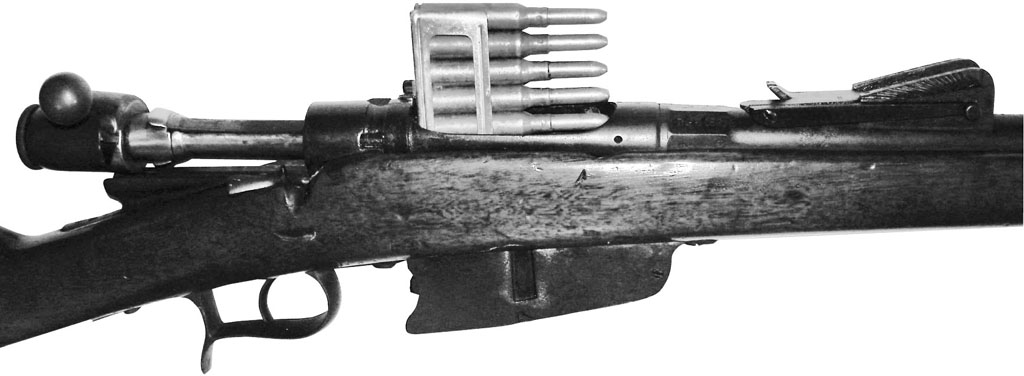
Vetterli Model 1870/87/15 action
Exc. |
V.G. |
Good |
Fair |
850 |
650 |
500 |
250 |
Model 1882 Naval Rifle
This rifle used the Model 1870 action. Fitted with a 28.75” barrel and chambered for the 10.4×47R Vetterli-Vitali cartridge. Full stocked. Weight is approximately 9 lbs. This model had no loading port but was charged by loading through the open action. The tube held 8 rounds. Made at Turni.
Exc. |
V.G. |
Good |
Fair |
850 |
650 |
500 |
250 |
Model 1870/87 Rifle/Carbine (Vetterli-Vitali)
This rifle was the same as the Model 1870 with the important exception of having been converted to magazine feed. The 4-round magazine was developed by Guiseppe Vitali. The magazine is unusual because the charger had to be fully inserted and then withdrawn with a string as the cartridge stripped away. Over 1,000,000 of these rifles were issued. A large number of these converted rifles and carbines were sold to Russia.
Exc. |
V.G. |
Good |
Fair |
750 |
650 |
500 |
250 |
Model 1870/87/15 Rifle (Vetterli-Vitali)
During WW1 nearly all the remaining model 1870/87 rifles were converted to use the 6.5×52mm Italian service ammunition. This was done by soldering a liner with 6.5mm bore in the original barrel. A new magazine was installed that allows use of the Mannlicher-Carcano six shot clip. This is the most common Italian Vetterli to be found in the U.S. today.
Exc. |
V.G. |
Good |
Fair |
300 |
250 |
175 |
125 |
Bayonets for Vetterli series
Model 1870/87
Wood grips. Muzzle ring. Hook quillon. 22.5” single edge blade. Brass tipped leather scabbard. Frequently found without a scabbard. Price range 200 – 100.
Model 1870/87/15
The model 1870/87 bayonets were converted by shortening the blade to 9.1” and the quillon was removed. The leather scabbards were also shortened. Price range 125 – 60.

Bayonet for Model 1870/87/15

Bayonet for Model 1870/87
NOTE: For drawings, data, and history see The Carcano: Italy’s Military Rifle by Richard Hobbs, 1997.
Fucile Modello 1891 Rifle
Designed by Salvator Carcano, the Model 1891 was adopted as Italy’s standard service rifle in 1892. A 6.5×52mm caliber bolt action rifle with a 30.6” barrel, 6-shot Mannlicher clip loading magazine, full-length stock, split bridge receiver, and a tangent rear sight with a wooden handguard and barrel bands retaining the stock. Fitted for a knife-type bayonet. On early versions the barrel behind the rear sights is octagonal. Weight is about 8.5 lbs. Produced at the Brescia, Terni, Roma, Torino and Beretta arsenals. On post-1922 examples Roman numerals appear on the upper right barrel flat, denoting the year of the Mussolini rule. Adding the Roman numeral to 1922 will provide the year of production. So, a Carcano with the Roman numeral XIV (14) was made in 1936. Many millions of this rifle were produced through WWII.
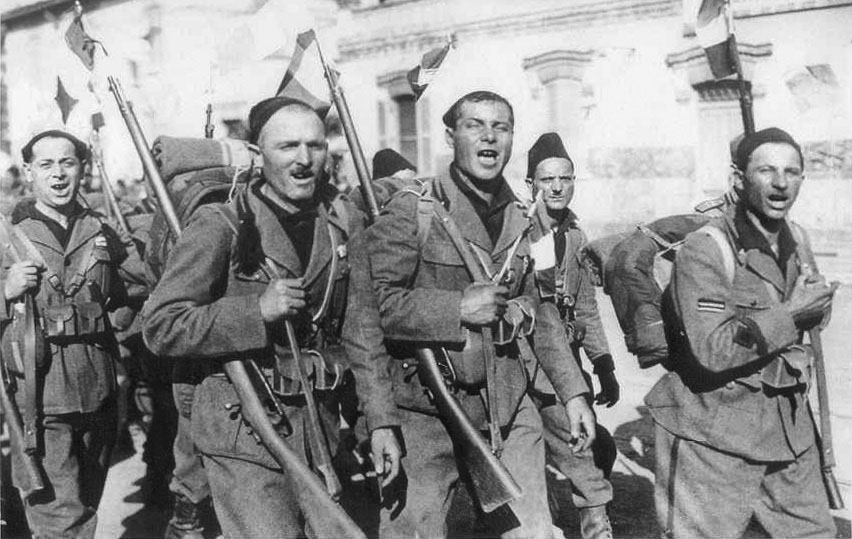
Italian troops with their Carcano rifles • Courtesy Paul S. Scarlata
Exc. |
V.G. |
Good |
Fair |
450 |
300 |
225 |
175 |
Bayonet for Mannlicher Carcano Models 1891
and 1941
Wood grips. Muzzle ring. 11.8” single edge blade. Early issue pieces came in a brass-tipped leather scabbard. At some point they began making the scabbards from steel. Most of the metal scabbards have a fluted surface, similar to those found on the Finnish Mosin Nagant bayonets. Price range 125 – 50.
Model 1891 Cavalry Carbine (Moshetto)
Same as above but half stocked with an 18” barrel with folding bayonet attached to the muzzle. Weight is about 6.5 lbs.
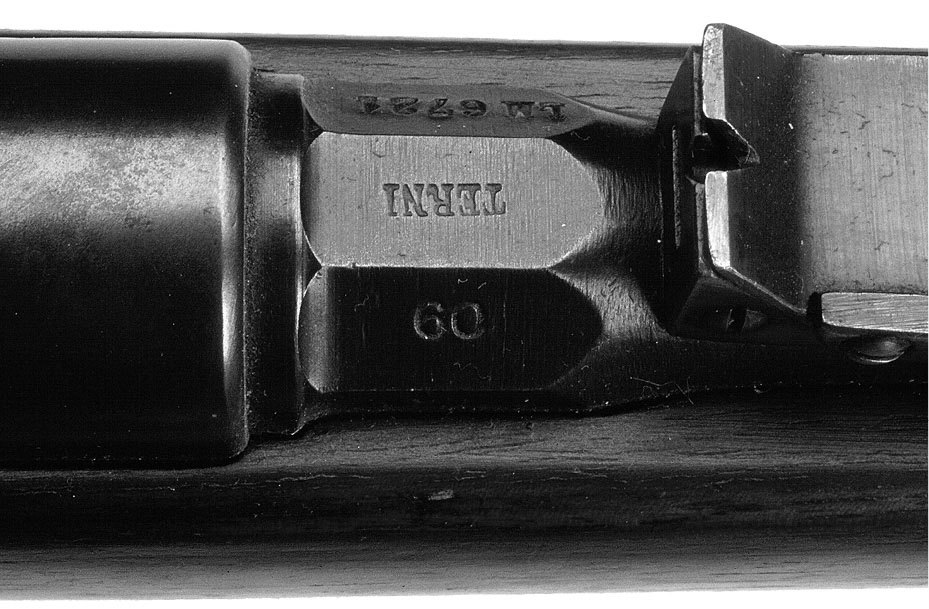

Model 1891 Rifle • Courtesy West Point Museum, Paul Goodwin photo

Bayonets for Mannlicher Carcano Models 1891 and 1941



Model 91 TS Carbine showing bayonet fitting • Private collection, Paul Goodwin photo
Exc. |
V.G. |
Good |
Fair |
400 |
300 |
200 |
150 |
Model 1891 TS (Truppe Speciali)
Similar to the Carbine above but without permanently attached bayonet. The original version of the TS pattern takes a unique bayonet. The nose cap has a bayonet lug that is side ways to the barrel. The bayonet slides over the barrel then turns to the side to latch. Later TS versions did away with this bayonet and use the standard 1891 pattern.
Exc. |
V.G. |
Good |
Fair |
400 |
300 |
250 |
150 |
Bayonet for Model 1891 T.S.
The same as the 1891 bayonet but has a lateral slot in the top of the pommel for mounting on the T.S. carbine. Discontinued after a short time, these bayonets are rare. Price range 250 – 125.
Model 1891/24 Carbine
Many Model 1891 rifles had the barrels shortened to 18 inches. This model will resemble the TS. The conversion was approved in 1924. They retain the longer rear sight graduated to 2000 meters. Takes the same blade bayonet as the Model 1891 rifle.

Courtesy Richard M. Kumor Sr.
Exc. |
V.G. |
Good |
Fair |
350 |
275 |
225 |
150 |
Model 1891/28 Carbine
Similar in appearance to the Model 1891/24 carbine. This version was produced between 1928 and 1938 with barrel dates so stamped. The main difference in in the rear sight, which is adjustable from 600 to 1,500 meters. Produced at a number of different Italian arsenals. Weight is about 6.75 lbs.
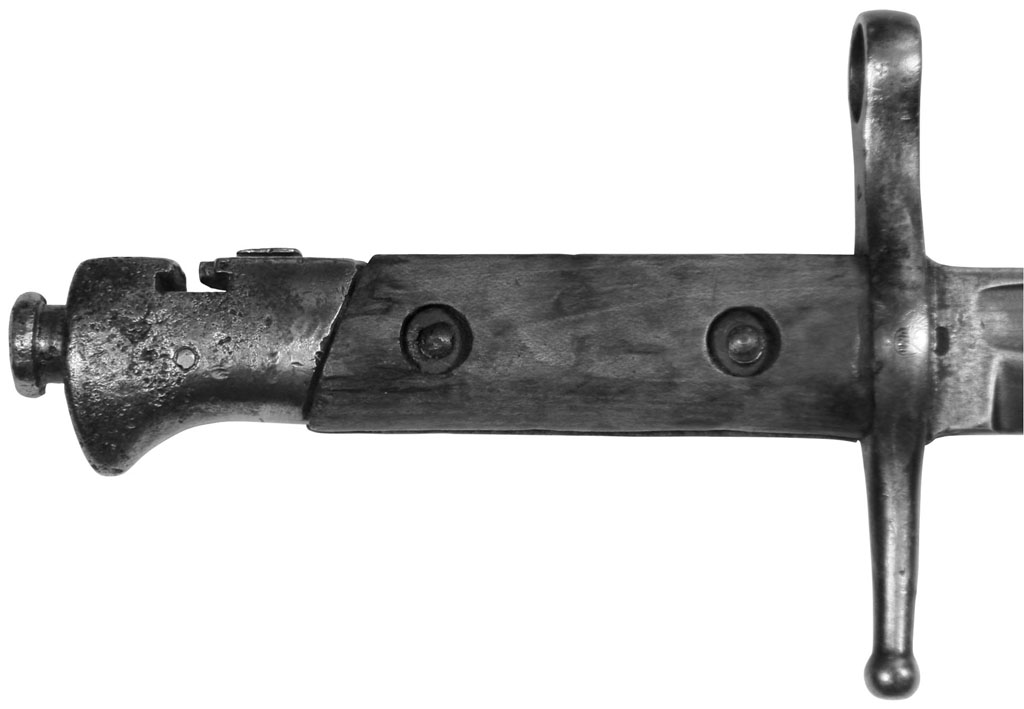
The handle of a 1891 Troop Special bayonet showing the unique attaching slot

M91/28 Carbine with grenade launcher • Courtesy Richard M. Kumor Sr.
Exc. |
V.G. |
Good |
Fair |
350 |
275 |
225 |
150 |
NOTE: The grenade launcher was called the “Tromboni Launchi Bombe.” Add 200 percent for any Carcano with a grenade launcher.
Model 1938 Short Rifle (Prototype)
This model is chambered for the 7.35×51mm cartridge and fitted with a 22” barrel. It has a 6-round detachable box magazine. Bent bolt handle. It is full stocked with one barrel band and exposed barrel and bayonet lug. Long handguard. Simple fixed rear sight. Weight is about 7.5 lbs. Produced at the Terni arsenal. Very rare.
Exc. |
V.G. |
Good |
Fair |
N/A |
— |
— |
— |
Model 1938 Short Rifle (Production version)
As above but with two barrel bands and half-length handguard. The left side of the butt stock is marked in large letters “cal. 7.35.” Rear sight is fixed at 200 meters. Weight is about 6.5 lbs.
NOTE: This rifle marked the first new caliber for Italian military rifles, the 7.35mm. When World War II began, about 285,000 rifles had been built in 7.35mm. From then on all Model 1938 Short Rifles and their variants were produced in the older 6.5mm caliber.
Exc. |
V.G. |
Good |
Fair |
350 |
275 |
200 |
125 |
Bayonet for Model 1938 Carcano
Wood grips. Muzzle ring. 7” single edge blade. The original version of this bayonet has a folding blade which fit into a groove in the forestock of the rifle. The folding version was costly to produce and the blade lock was found to loosen up with use. A fixed blade version replaced it and many of the folding bayonets were converted to fixed style by changing the cross piece. The fixed blade version was issued in a steel scabbard. Price range, folding model, 250 – 125. Price range, fixed blade, 150 – 60.
Model 1938 Cavalry Carbine
This model has a 17.75” barrel. It is fitted with a folding bayonet that fits under the barrel when not deployed. Chambered for the 7.35×53mm or 6.5mm cartridge. Built by FNA in Brescia and other Italian firms. The rear sight is a fixed 200-meter sight for rifles chambered for the 7.35mm cartridge. Weight is about 6.5lbs. About 100,000 were produced. Original 7.35mm carbines are somewhat scarce and might bring a 25 percent premium.

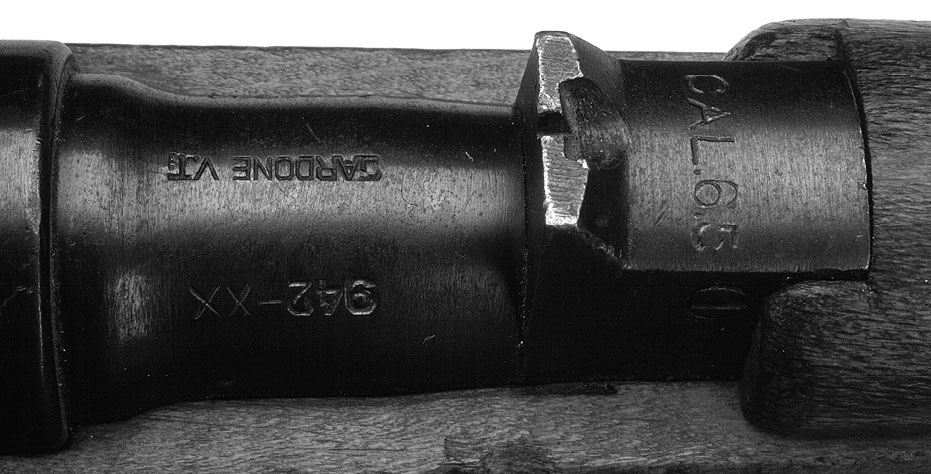
Model 1938 Carbine • Courtesy West Point Museum, Paul Goodwin photo

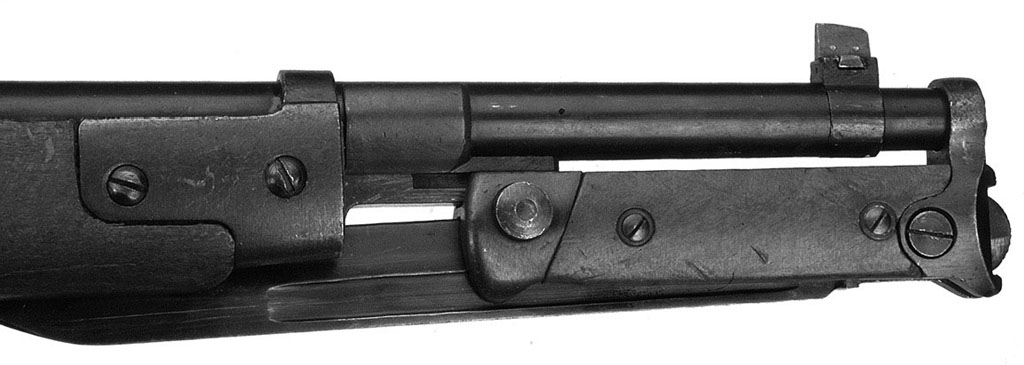


Model 1938 short rifle with the folding bayonet attached • Courtesy West Point Museum, Paul Goodwin photo
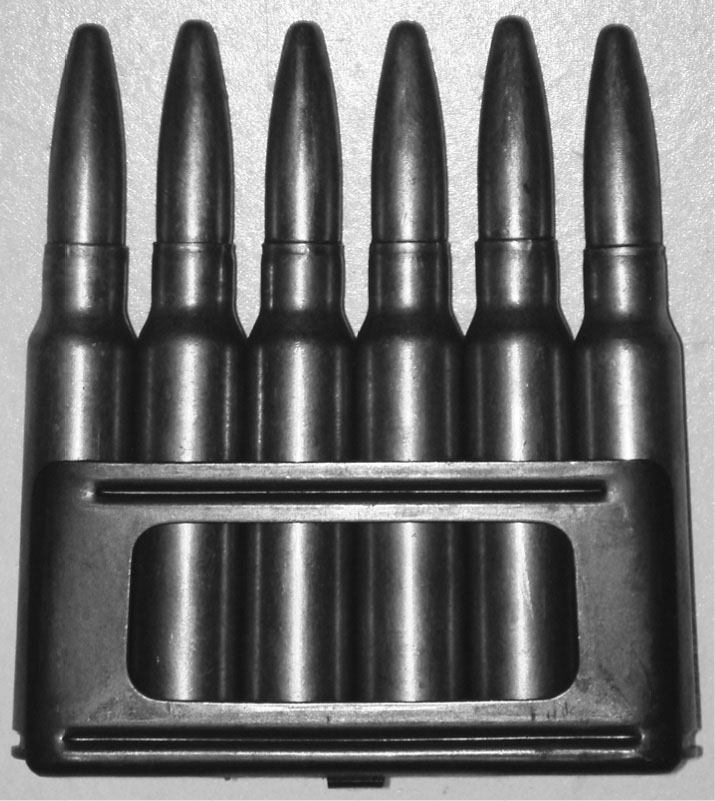
Clip for Mannlicher-Carcano. Brass or steel construction. Works with either 6.5mm or 7.35mm. Price 10-4
Exc. |
V.G. |
Good |
Fair |
350 |
275 |
200 |
125 |
Model 1938 T.S. Carbine
Same as 1891 T.S. carbine but with a fixed rear sight.

Courtesy Richard M. Kumor Sr.
Exc. |
V.G. |
Good |
Fair |
350 |
275 |
200 |
125 |
NOTE: For original M-38 T.S. carbines in 7.35mm add a premium of 50 percent.
Model 1938/43 Cavalry & T.S. Carbine converted to 7.9×57mm Mauser
During the last months of WWII the Germans converted some Carcanos carbines to use the 7.9 Mauser cartridge. They were not intended for front line service. This was done by boring out the original barrel. “7.9” is marked on top of the barrel in front of the receiver. Barrel length is 18.” Rear sight is fixed at 200 meters. Though they retain the Carcano magazine system, they were issued as single shots. The 7.9 Mauser cartridge is too large to fit in the Carcano clip or magazine. The work was done by the Heinrich Kreighoff company. Marked on the left side of barrel, receiver and stock with a new SN that starts with “K.” There is a small HK on top of receiver and a German eagle firing proof on the right side of chamber. These German conversions are rare.
Exc. |
V.G. |
Good |
Fair |
800 |
700 |
600 |
400 |
Post-WWII conversion to 7.9 Mauser
After WWII, many Carcano carbines were converted to 7.9 Mauser using the same process used by the Germans. History is unclear as to what country these were made for. It is likely they were done in Italy in order to make the tons of surplus Carcanos they had more sellable on the world arms market. Marked with a large “S” on top of the barrel. Some have “7.9” on the rear sight. No HK or other German marks. These are common on the U.S. market and are frequently confused with the much rarer German conversions.

Exc. |
V.G. |
Good |
Fair |
300 |
250 |
200 |
100 |
Model 1941 Rifle (1891/41)
This is a 6.5mm rifle fitted with a 27.25” barrel and 6-round detachable box magazine. Very similar to the Model 1891 but for length and rear sight from 300 to 1,000 meters. Weight about 8.2 lbs. Frequently found in excellent condition as they were un-issued when Italy ended its’ participation in WWII. Some were refinished after the war for export sales. They will be marked “Made in Italy” A few of these rifles were sold to Israel and will be marked with the Star of David.

Courtesy Richard M. Kumor Sr.
Exc. |
V.G. |
Good |
Fair |
300 |
250 |
175 |
125 |
Italian Youth Rifle (Moshetto Balia)
Smaller version of the Carcano 1891 Cavalry Carbine, with folding bayonet. Barrel length is 14.4”. Used for youth training and as awards in youth fascist groups. Not a real firearm, they were manufactured by toy companies. Although they appear to have a chamber, it is believed only blank cartridges were ever made for them. They would take a small version of the Mannlicher clip, although the clips are rarer than the guns, and none could be found to show in this book.

Courtesy Richard M. Kumor Sr.
Exc. |
V.G. |
Good |
Fair |
500 |
400 |
300 |
250 |
NOTE: Add $75 for dedication plaque.
Breda Model PG
Chambered for the 7×57mm rimless cartridge, this is a gas operated self-loading rifle with an 18” barrel and 20-round detachable box magazine. The particular rifle was made by Beretta for Costa Rica and is marked “GOBIERNO DE COSTA RICA,” with the date 1935 and Roman numerals XIII. Weight was about 11.5 lbs. Fitted for a Costa Rican Mauser bayonet. Very rare. Price listed is the author’s guess only. None found on the market.

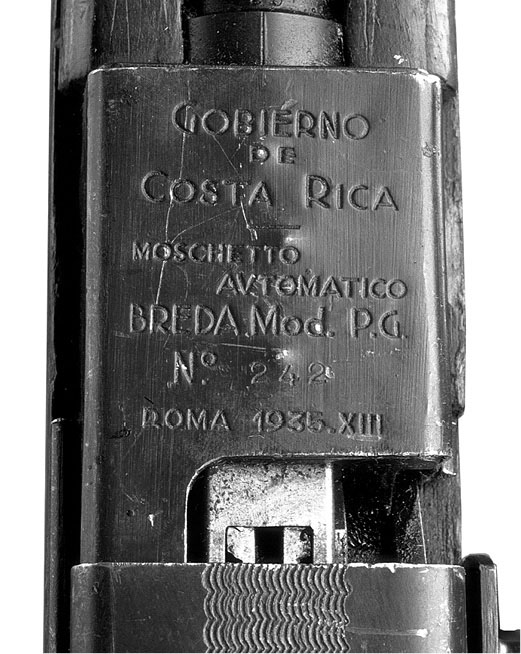
Breda Model PG • Paul Goodwin photo
Exc. |
V.G. |
Good |
Fair |
2500 |
2000 |
1500 |
1000 |
Beretta Model BM59-Select Fire Assault Rifle
This select fire rifle closely resembles the U.S. M1 Garand rifle. Chambered for the 7.62×51mm cartridge, it is fitted with a 19” barrel and 20-round magazine. It has a rate of fire of 750 rounds per minute. Weight is about 10 lbs. Marked “P BERETTA BM59” on the top rear of the receiver. Produced from 1961 to 1966. This rifle did see service in the Italian army. There are a number of variations to this rifle, including the BM59 Alpini with folding stock short forearm and bipod for use by Alpine troops, and the BM59 Parachutist Rifle with 18” barrel, folding stock, and detachable muzzle brake (the Italians referred to it as a Tri-Comp).
Pre-1968
Exc. |
V.G. |
Fair |
8500 |
7000 |
5000 |
Pre-1986 conversions of semi-automatic version
Exc. |
V.G. |
Fair |
5500 |
4250 |
N/A |


Model BM59 • Courtesy West Point Museum, Paul Goodwin photo
BM-59 Semi-Automatic
A gas-operated semi-automatic rifle with detachable box magazine. Chambered for .308 cartridge. Walnut stock. Barrel length is 19.3” with muzzle brake. Magazine capacity is 5, 10, or 20 rounds. Weight is about 9.5 lbs.
Exc. |
V.G. |
Good |
Fair |
2500 |
2000 |
1500 |
N/A |
Beretta AR70/.223 Select Fire Assault Rifle
Chambered for the 5.56×45mm cartridge, this select
fire rifle was fitted with a 17.5” barrel and a 30-round magazine. Most were fitted with a solid buttstock while others were fitted with a folding stock. Weight was about 8.3 lbs. Marked “P BERETTA AR 70/223 MADE IN ITALY” on the left side of the receiver. This rifle was not widely adopted. Produced from 1972 to 1980.

Courtesy private NFA collection
Pre-1968 (Rare)
Exc. |
V.G. |
Fair |
N/A |
N/A |
N/A |
Pre-1986 conversions of semi-automatic version
Exc. |
V.G. |
Fair |
10000 |
7500 |
5000 |
Beretta SC 70 Select Fire Assault Rifle
Similar to the AR 70 and chambered for the 5.56×45mm cartridge. It feeds from a 30-round magazine. The SC 70 has a folding stock and is fitted with a 17.5” barrel. Weight is about 8.8 lbs. The SC 70 short carbine also has a folding stock and is fitted with a 13.7” barrel. Weight is about 8.3 lbs. Both of these rifles are still in production and used by the Italian army since approved for service in 1990.

SC 70 Carbine • Courtesy private NFA collection
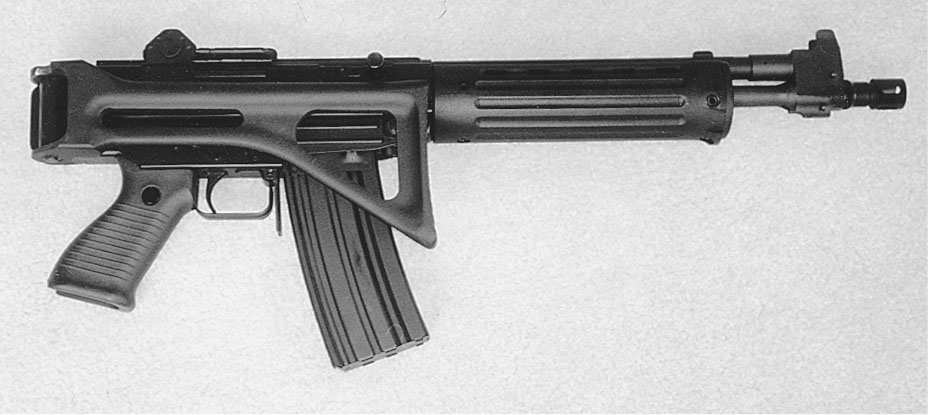
SC 70 Short Carbine • Courtesy private NFA collection
Pre-1968
Exc. |
V.G. |
Fair |
N/A |
N/A |
N/A |
Pre-1986 conversions of semi-automatic version
Exc. |
V.G. |
Fair |
10000 |
8000 |
N/A |
AR-70
A .223 caliber, semi-automatic rifle with a 17.7” barrel, adjustable diopter sights, and an 8- or 30-shot magazine. Black epoxy finish with a synthetic stock. Weight is approximately 8.3 lbs.
NIB |
Exc. |
V.G. |
Good |
Fair |
2500 |
2400 |
1900 |
1500 |
N/A |
Bayonet for BM-59 and AR-70
This bayonet is a variation on the U.S. M-1 carbine bayonet and the dimensions are the same. It has a hard plastic handle. It is currently used on the Beretta-made rifles. Price range 250 – 100.
Franchi SPAS 12
A 12 gauge, slide-action or semi-automatic shotgun with a 21.5” barrel and 9-shot magazine. Anodized black finish with a composition folding or fixed stock. Weight is about 9.25 lbs.

Exc. |
V.G. |
Good |
Fair |
1000 |
900 |
750 |
N/A |
Franchi SPAS 15
Similar to the SPAS 12 but with a detachable 6-round box magazine. Tubular steel folding stock and 18” barrel or fixed stock with 21” barrel. Weight is about 8.5 lbs. Very few imported into the U.S.
Exc. |
V.G. |
Good |
Fair |
6000 |
4500 |
3000 |
N/A |
NOTE: For guns with folding stock and 18” barrel add $1,000.
Italy used the Maxim Model 1906 and Model 1911. Both of these models were chambered for the 6.5mm cartridge. During WWI, Italy purchased a number of Colt Model 1914 guns (Potato Diggers) chambered for the 6.5mm cartridge. When the war ended, Italy received a large number of Austrian Schwarzlose Model 1907/12 as war reparations. The first Italian light machine gun was the Breda Model 1924, the forerunner of the Breda Model 30.
After WWII, Italy adopted the U.S. Model 1919A4 and .50 NM2 HB guns, as well as the MG42/59, for which several Italian firms make the components under license.


Revelli Model 1914 • Courtesy private NFA collection, Paul Goodwin photo

World War I Italian machine gun team with Model 1914 Revelli • Robert G. Segel collection
Beretta M70/78
Similar to the Model 70/223 but fitted with a heavy 17.5” barrel. Magazine capacity is 30 or 40 rounds. Rate of fire is 700 rounds per minute. Marked “P BERETTA FM 70/78 MADE IN ITALY” on left side of the receiver. First produced in 1978 with production ending in 1983.
Pre-1968
Exc. |
V.G. |
Fair |
N/A |
N/A |
N/A |
Revelli Model 1914
This was the first Italian-designed medium machine gun to be made in quantity. It was chambered for the 6.5mm cartridge and fitted with a 26” barrel. It was fed by a unique 50-round magazine with 10 compartments holding 5 rounds each. Because of its blowback system where the barrel moved a short distance rearward before the bolt moved away from the breech, there was no extraction system other than to oil the cartridges so that they did not rupture. Rate of fire was about 400 rounds per minute. Weight was 38 lbs. without tripod, 50 lbs. with tripod. The gun was manufactured by Fiat. Many of these guns were used by the Italians in WWII as well as in WWI.
Pre-1968
Exc. |
V.G. |
Fair |
18000 |
12500 |
10000 |
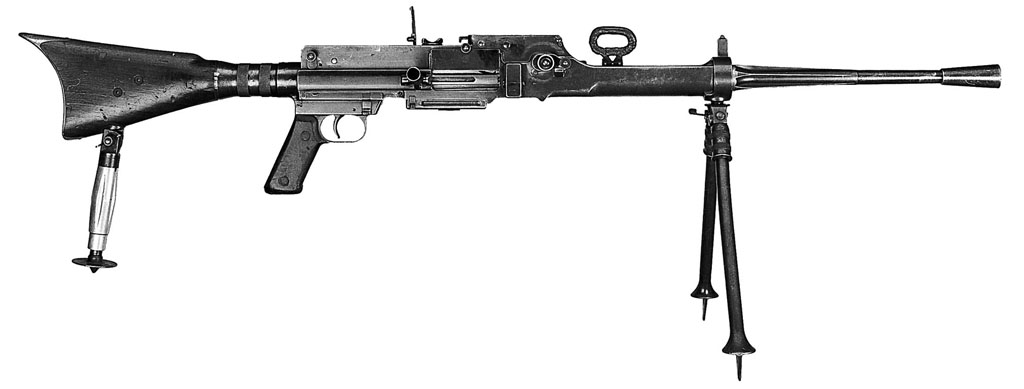

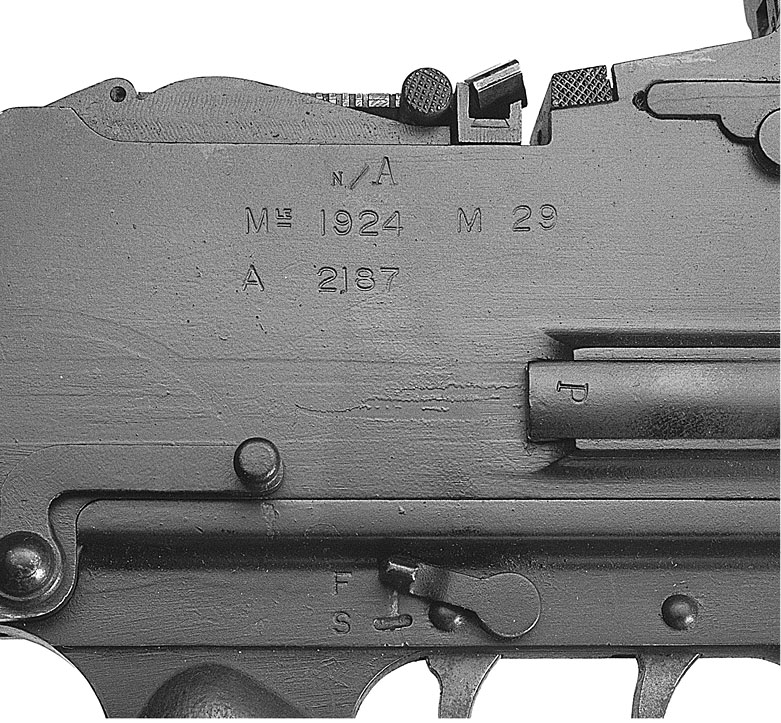
Fiat Model 1928 • Courtesy private NFA collection, Paul Goodwin photo
Fiat Model 1928 (SAFAT)
This is a light version of the Revelli Model 1914. Chambered for the 6.5 Carcano cartridge. Magazine is a 20-round magazine. Rate of fire is about 500 rounds per minute. Weight is approximately 21 lbs. Only a few thousand were manufactured during its limited production. Very rare.
Pre-1968
Exc. |
V.G. |
Fair |
N/A |
N/A |
N/A |
Revelli/Fiat Model 35
This is a converted Revelli Model 1914 to 8mm. It is an air-cooled gun. It is fed by a 300-round belt. It’s fired from a closed bolt. It was not a successful gun. Weight without tripod was 40 lbs.
Pre-1968
Exc. |
V.G. |
Fair |
16000 |
15000 |
14500 |
Breda Model 30
First produced in Italy in 1930, this machine gun was chambered for the 6.5×52mm cartridge. It is fitted with a 20.3” barrel. Magazine capacity is 20 rounds. Rate of fire is 475 rounds per minute. Marked “MTR LEGG MOD 30….BREDA ROMA” on top of receiver. Weight is about 22 lbs. Production on this model ceased in 1937. This was the primary Italian machine gun of WWII.
NOTE: A number of pre-1968 7mm Costa Rican contract guns are in the U.S. These are valued the same as the 6.5mm guns.


Fiat Model 35 • Courtesy private NFA collection, Paul Goodwin photo

Breda Model 30 with receiver markings • Paul Goodwin photo
Pre-1968
Exc. |
V.G. |
Fair |
15000 |
12500 |
10000 |
Breda Model 37
Chambered for the 8×59 Breda cartridge, this gas operated machine gun had a rate of fire of 450 rounds per minute. It was fitted with a 26.5” barrel and weighs approximately 43 lbs. It was fed with a 20-round strip. Marked “MITRAGLIATRICE BREDA MOD 37” on the left side of the receiver. Produced from 1936 to 1943, this was the standard heavy machine gun of the Italian army during WWII. The Model 37 was considered to be one of the best Italian machine guns used in WW II, mainly because of its reliability and accuracy.
Pre-1968
Exc. |
V.G. |
Fair |
28000 |
25000 |
18000 |



Breda Model 37 with receiver markings • Paul Goodwin photo